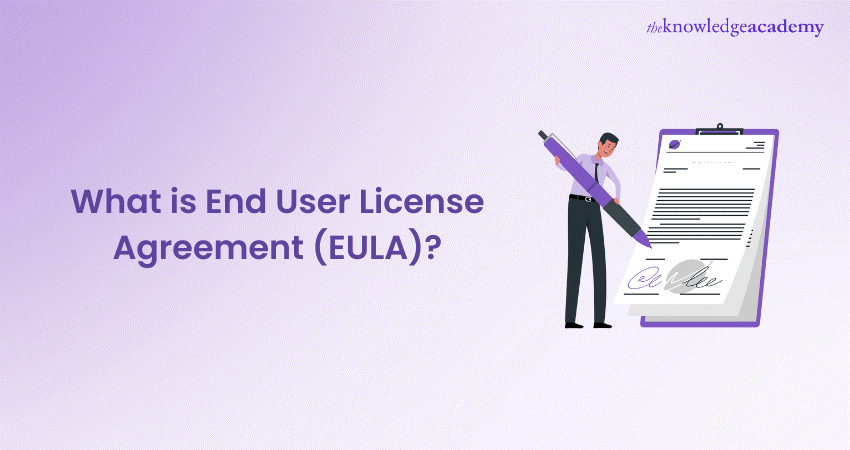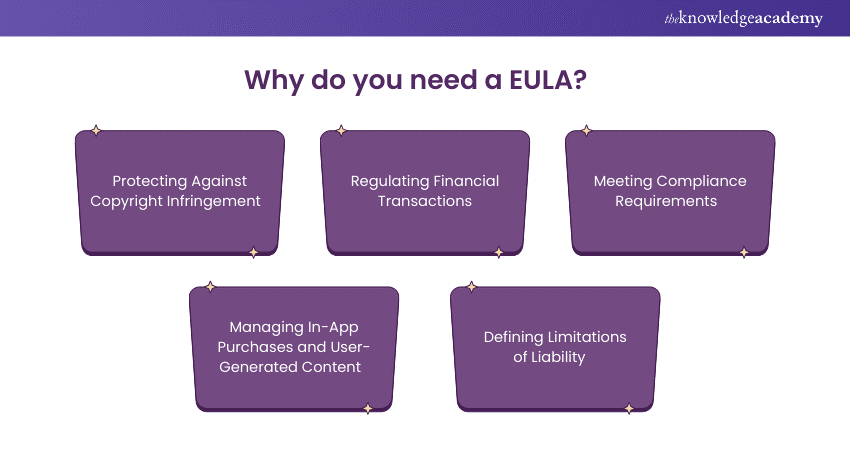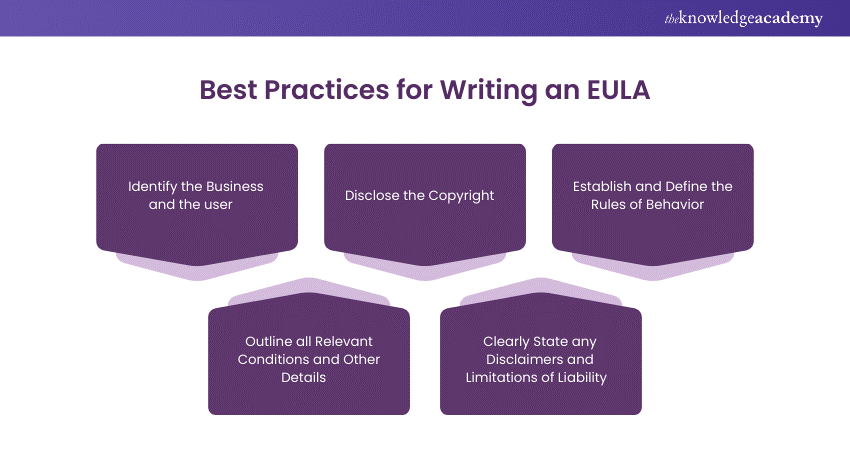We may not have the course you’re looking for. If you enquire or give us a call on +91-181-5047001 and speak to our training experts, we may still be able to help with your training requirements.
Training Outcomes Within Your Budget!
We ensure quality, budget-alignment, and timely delivery by our expert instructors.

An End User License Agreement (EULA) is a crucial legal document in the software industry, defining the relationship between the software developer and the end user and outlining the terms of software usage. This blog explores what a EULA is, its purpose, how to create one, best practices for drafting an effective EULA, and the benefits it provides to both software vendors and users.
This blog gives an overview on What is End User License Agreement, its purpose, steps required to create one and best practices. Continue reading below to know more!
Table of Contents
1) Understanding an End User License Agreement (EULA)
2) Purpose of End User License Agreement (EULA)
3) Steps to Create an EULA
4) Why Do you Need a EULA?
5) What Does a EULA Include?
6) What are Best Practices for Writing an EULA?
7) Advantages of EULA
8) Conclusion
Understanding an End User License Agreement (EULA)
In the digital world, EULA contracts are the most used when defining a product's terms and conditions. The product could be software, mobile apps, games, and software as a Service (SaaS). This agreement is the first thing a user sees when software is installed on the device. EULA clearly states the ownership of the software vendor and how the End-User gates through the software. EULA involves two parties:
Licensor or Service Provider: The Licensor owns all the rights to the product or service. It could be a company, author, or individual.
Licensee or Buyer: Buyers grant permission to use the product or service provided by the Licensor. However, buyers are supposed to accept the terms and conditions.
Other names for EULA include:
a) Software license agreement
b) Terms and conditions agreement
c) Shrink wrap license
d) Click-wrap license
e) Licensing agreement
The EULA covers everything relating to the license of software, fees and websites. The EULA protection right provides disclaimer warranties, liabilities, license termination, and ownership rights.
Purpose of End User License Agreement (EULA)
An End User License Agreement has various purposes along with the guidelines. Given below are some of them:
1) Curb Infringements: The EULA restricts the buyer's modification of the product or service. Activities such as product replication, third-party distribution, and Reverse Engineering are strictly prohibited.
2) Provide Control: Licensors maintain complete control over the software. For example, you can choose whether the product is for personal or commercial usage and revoke the product license. The EULA also includes clauses regarding termination and user volitation. Essential clauses include licensor information, date, and software information. After reading these clauses, buyers can gain a better understanding of the product.
The main goal of the End User License Agreement is to ensure that the relationship between the buyer and service provider remains intact. The contract also protects the Licensor's rights from non-transferability, resale/distribution, etc.
Apart from this, EULA establishes some guidelines for the usage of products or services.
3) Usage Restriction: EULA clearly states what actions a user must perform while handling the product or service. Some of the things a user cannot do include:
a) Software reverse engineering
b) Distribution to third parties
c) Illegal usage
d) Software modification
4) Grant License: The EULA clearly specifies the buyer's ownership rights, noting that ownership is not transferable under any circumstances.
5) Warranty Disclaimer: The Licensor provides warranty disclaimers indicating no promises are made regarding the product's functionality. If the buyer incurs any loss, the Licensor is not responsible.
6) Trespass of Copyright: The copyright of intellectual property is owned by the Licensor. Clauses protect any trespassing of copyright by the user.
7) Liability Limitation: This is the most critical EULA clause as it clarifies the compatibility of the product or services. The service provider is not liable for personal injury, malfunction, loss of reputation, or damage caused.
8) Other Agreements: EULA also includes privacy policies, apart from the terms and conditions.
Gain in-depth knowledge of Microsoft Fluid with our comprehensive Microsoft Fluid Framework Training. Empower your team with cutting-edge skills for seamless collaboration.
Steps to Create an EULA
Now, you understand what EULA is and its purpose. Now, let’s move on to craft an EULA. Follow the instructions below steps to create EULA perfectly:

Identify the Involved Parties
Clearly identify the parties involved in the EULA. This includes the licensor, who is the software developer or publisher owning the software and granting the license, and the licensee, who is the end user acquiring the rights to use the software under the specified terms. Proper identification ensures there is no ambiguity about who is bound by the terms of the agreement.
License Grant
License grant specifies how the license is used, such as whether it is transferable, exclusive, or not. It covers all the things a user can do, and in general, it covers the scope of the license.
Usage Restrictions
Some restrictions include not distributing, copying, or modifying the software. It is important to state these prohibitions in the beginning so that the buyer does not experience harm later.
Termination Conditions
Define the conditions under which the license can be terminated. This might include a breach of the terms of the EULA, non-payment for the software, or engaging in prohibited activities. Clearly specifying termination conditions ensures both parties are aware of the consequences of violating the agreement, providing a clear framework for resolving issues.
Warranties and Disclaimers
The software license comes with no guarantee or warranty. This means the Licensor is not liable for product performance, suitability, and reliability and is also free from any defect or failure related to the software.
Limitation of Liability
The EULA limits any liability for damage or harm arising while using the product, including consequential damages, indirect disclaimers, and incidental damages. This clause safeguards the Licensor from user claims.
Specify Jurisdiction
Jurisdiction laws govern the End User License Agreement, providing legal clarity and transparency. The jurisdiction clause covers both country and state legal provisions.
Provide Contact Information
The EULA clearly states the Licensor's contact information to support the user. In case the user experiences any difficulty or issue with the product, customer support is available 24/7.
Why do you need a EULA?
An End User License Agreement ensures the owner of the product or service holds 100% rights. However, in some cases, the requirements of EULA change.

1) Protecting Against Copyright Infringement
EULA protects the Licensor against property theft. For example, game developers can mention that users can recreate the game without claiming ownership of the original version.
2) Regulating Financial Transactions
The EULA regulates transactions if the product or service involves purchases or transfers. For example, the clause includes payment processing through PayPal or international wire transfers.
3) Meeting Compliance Requirements
The EULA is vital to meeting compliance requirements like account deletion, backup data, and ticket raising. The End User License Agreement must include a clear and concise outline.
4) Managing In-App Purchases and User-Generated Content
The clause should also mention in-app purchases and user-generated content for more clarity. For example, tokens in games that can be redeemed.
5) Defining Limitations of Liability
The Licensor should specify under what conditions the product or service can misbehave or not work well, such as virus attacks or software break-ins. The EULA states what can be fixed with updates and what cannot.
Unlock your potential with our Computer Science Course! Gain essential tech skills and knowledge to succeed
What does a EULA include?
The End User License Agreement is different for different businesses. It is tailored to the owner's requirements. However, it includes things like:
a) Privacy Policy: The privacy policy section of a EULA details how the licensor collects, uses, and protects the personal information of the licensee. It typically includes information on what data is collected, how it is used, who it is shared with, and how it is protected. The privacy policy also outlines the rights of the user regarding their personal data, including how they can access, correct, or delete their information.
b) Warranty & Disclaimer: The warranty and disclaimer section is essential for limiting the liability of the licensor. This section typically includes disclaimers of warranties, stating that the software is provided "as is" and without any guarantees of performance, reliability, or suitability for a particular purpose. It clarifies that the licensor does not make any promises regarding the software's functionality and that any use of the software is at the user's own risk.
c) Indemnification: The indemnification clause requires the licensee to compensate the licensor for any losses, damages, or legal costs incurred due to the licensee's misuse of the software or breach of the EULA terms. This section typically states that the user agrees to defend, indemnify, and hold harmless the licensor from any claims or actions arising from their use of the software.
d) Termination: The termination section outlines the conditions under which the EULA can be terminated by either party. This might include breaches of the terms of the agreement, non-payment for the software, or misuse of the software.
What are the Best Practices for Writing an EULA?
An End User License Agreement comes with some protocols and formats. Here are some of the best practices for writing an EULA:

Identify the Business and the user
Since the EULA is a vital contract, identifying the parties becomes the first step. In the EULA, both Licensor and licensee must be stated clearly. Both will be responsible for fulfilling the terms of use.
Disclose the Copyright
nclude a statement that the software is protected by copyright and that the provider retains all intellectual property rights. This helps protect the software from unauthorised use, distribution, and replication. Clearly stating the copyright ownership reassures the users that the software is legally protected and that any violations will have legal consequences.
Establish and Define the Rules of Behavior
Establishing rules and regulations enables users to behave under control. As the owner of the product or service, you must clearly define rules and restrictions. In the absence of rules, the license can be misused.
Outline all Relevant Conditions and Other Details
The End User License Agreement should also outline relevant terms and conditions regarding the software usage. The condition showcases scenarios where the usage can be terminated or revoked. That’s why outlining all relevant conditions and details is necessary.
Clearly State any Disclaimers and Limitations of Liability
Finally, the EULA must define disclaimers and limitations of liability to protect the ownership of vendors. It is also necessary to outline important protocols to be followed while using the software. Hence, clearly state any disclaimers and limitations of liability.
Advantages of EULA
An End User License Agreement (EULA) offers numerous advantages for both software vendors and customers. By establishing clear terms of use, EULAs help protect intellectual property, define user rights and responsibilities, and provide a legal framework for resolving disputes. Here are some of the primary advantages of implementing a comprehensive EULA:
Protection of Intellectual Property
One of the most significant benefits of a EULA is the protection of the software vendor's intellectual property. By explicitly prohibiting activities such as copying, modifying, distributing, or reverse engineering the software, the EULA helps safeguard the vendor's proprietary technology and innovations.
Limitation of Liability
A well-drafted EULA includes clauses that limit the vendor's liability in case the software fails to perform as expected or causes damage. This limitation of liability protects the vendor from potentially costly legal claims and ensures that users understand the risks associated with using the software.
Control Over Software Usage
The EULA allows vendors to maintain control over how their software is used. This includes specifying whether the software is for personal or commercial use, setting limits on the number of installations or users, and defining the scope of the license. Such control helps vendors ensure that their software is used in accordance with their business objectives.
Compliance with Legal Requirements
A EULA helps software vendors comply with various legal and regulatory requirements. By including terms related to data protection, privacy policies, and export control laws, the EULA ensures that the software vendor meets industry-specific standards and avoids legal complications.
Revenue Protection
By defining the terms of software usage and prohibiting unauthorised distribution, the EULA helps protect the vendor's revenue streams. It prevents piracy and unauthorised sharing, ensuring that only paying customers can legally use the software. EULA protect your business revenue.
Conclusion
In conclusion, the End User License Agreement plays a crucial role in defending the rights of product owners. Here, the product could be software, SaaS, or any good. A well-structured EULA made using best practices curbs product infringements, third-party distribution, and misuse. The owner has the right to revoke or suspend in case of volatility of rules.
Learn high-level technical software skills with our End User Training- join now!
Frequently Asked Questions

EULA is known for protecting the rights of vendors till the end. Whereas the Software License Agreement sets usage targets for buyers for a specific period. Both are important agreements.

The End User License Agreement deals explicitly with digital goods and software. However, the basic rules and regulations remain the same for both entities. Both don’t grant customers ownership. EULA can apply to numerous types of services and products that are digital.

EULAs are complex documents, and users may find it difficult to read and remember all the clauses. Some disadvantages include data breaches, distribution to third parties, and malfunctioning. Other disadvantages include usage restriction, unilateral terms, and warranty limitations.

The Knowledge Academy takes global learning to new heights, offering over 30,000 online courses across 490+ locations in 220 countries. This expansive reach ensures accessibility and convenience for learners worldwide.
Alongside our diverse Online Course Catalogue, encompassing 17 major categories, we go the extra mile by providing a plethora of free educational Online Resources like News updates, Blogs, videos, webinars, and interview questions. Tailoring learning experiences further, professionals can maximise value with customisable Course Bundles of TKA.

The Knowledge Academy’s Knowledge Pass, a prepaid voucher, adds another layer of flexibility, allowing course bookings over a 12-month period. Join us on a journey where education knows no bounds.

The Knowledge Academy offers various End User Training , including the Computer Science Course, and Microsoft Fluid Framework Training. These courses cater to different skill levels and provide comprehensive insights into Computer Science Skills
Our Office Application Blogs cover a range of topics related to End User, offering valuable resources, best practices, and industry insights. Whether you are a beginner or looking to advance your End User Skills, The Knowledge Academy's diverse courses and informative blogs have got you covered
Upcoming Office Applications Resources Batches & Dates
Date
 Computer Science Course
Computer Science Course
Fri 7th Feb 2025
Fri 4th Apr 2025
Fri 6th Jun 2025
Fri 8th Aug 2025
Fri 3rd Oct 2025
Fri 5th Dec 2025







 Top Rated Course
Top Rated Course



 If you wish to make any changes to your course, please
If you wish to make any changes to your course, please


